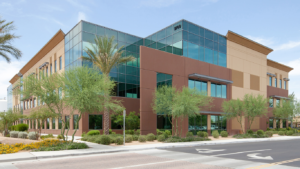Joe Snell, president and CEO of Tucson Regional Economic Opportunities (TREO), provided insight on the latest growth initiatives in Tucson and what the city needs to do to continue its upward trajectory.

What are Tucson’s strongest assets coming into the recovery?
❚ The University of Arizona is a Top 20 research university with amazing strengths in engineering, science, optics, entrepreneurship and provides a robust talent pipeline companies are looking for.
Tucson has an established, diverse aerospace and defense industry, with more than 200 companies, and an emerging bioscience sector with strong contribution to the state’s Bioscience Roadmap.
❚ Its strategic location. Southern Arizona is truly a gateway to Mexico. In addition to the unique rail assets we already have, we will leverage Mexico’s Port of Guaymas expansion to our benefit. Also Tucson’s position at the southern end of the Sun Corridor location in our mega region, expected to have the most growth in the next 35 years, positions us for business investment for years to come.
❚ On the heels of Arizona’s high national entrepreneurship rankings, Tucson is beginning to receive national recognition for its own entrepreneurial culture. For example, Entrepreneur magazine recognized Tucson last August as one of the best cities for entrepreneurs. With these state and local rankings giving Tucson needed exposure, the McGuire Entrepreneurship Program at The University of Arizona’s Eller College of Management, the new Tech Launch Arizona initiative, Start Up Tucson, a strong Desert Angels group, and various public and private organizations, Tucson supports start-up businesses and entrepreneurs with resources for launching new ventures.
❚ Progress in downtown revitalization.
TREO just released its 2014 updates to its Economic Blueprint. Describe the “urban renaissance” on which Tucson is focused.
❚ As the national and local economies slowed around 2008, Tucson’s long-term downtown development momentum picked up steam. Over the last three-plus years, huge and exciting changes have come to downtown Tucson by way of over $320M in public and private investment. Some notable projects include UniSource Energy’s new corporate headquarters, other headquarters such as Providence Service Corp., Mr. Car Wash, Sonoran Institute and Madden Media; the Tucson Modern Streetcar and a new UA downtown branch, among many other retail and restaurants new to downtown. Some of those changes are more visible than others, but together they add up to a more exciting, more vibrant, more inviting downtown for everyone, but especially the young, creative class that is just discovering Tucson.
Infrastructure, specifically related to transportation, is another big initiative in TREO’s Economic Blueprint. What are some of the short-term goals TREO hopes to see happen?
❚ Infrastructure investment is really a path for economic growth, and expansion of existing highway, rail and airport capacity is the key to global competitiveness. We are fortunate in southern Arizona. Our location in the Sun Corridor puts the Tucson region at the crossroads for trade corridors in all directions. Many communities would covet this position, so we must be laser-focused and smart about how we go about ensuring that we invest in the right transportation infrastructure. We are focusing on three key areas. First, achieving seamless connectivity to Mexico and other southwestern markets. We, as a region, have the ability to influence the inclusion of the southern segment of I-11 and the border-to-border vision of the Intermountain West Corridor in federal and state planning. We have made a great start but have much more to do. Second, we are focused on supporting Tucson International Airport, rail asset capacity growth and local mobility initiatives. Expanding passenger and freight service at Tucson International Airport will mean increased commerce for the entire region. We also have to make the proposed Aerospace Corridor and associated research park, rail reclassification facilities and the 10/I19 Bypass realities. Third, how do we pay for all this? Creative funding and private sector solutions are required to ensure our region continues to have the resources to be competitive in the marketplace. We will be actively participating in the development of new funding mechanisms.
What are some of the challenges TREO has overcome or anticipates?
❚ Over the last nine years, we have made progress in our focus on business development and economic diversification through targeted industries. We are laser-focused on four industries that can shape our future: aerospace and defense, alternative energy and natural resources, transportation and logistics, and bioscience/healthcare. Most of our successful projects over the last several years fall into these categories. In addition, we have dramatically increased private sector support of TREO and the understanding of the importance of economic development with all of our regional partners, public and private. Obstacles and opportunities include the unification/cooperation among many groups, accountability, common definitions of economic development and increased funding is critical for success.




